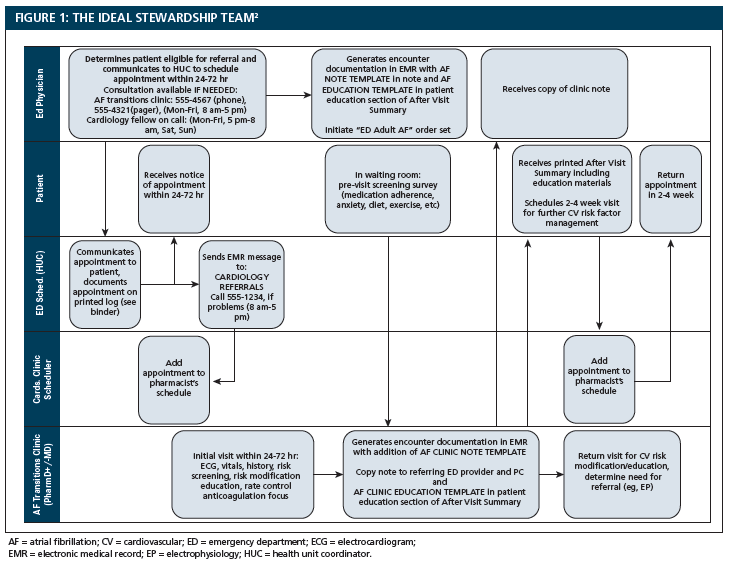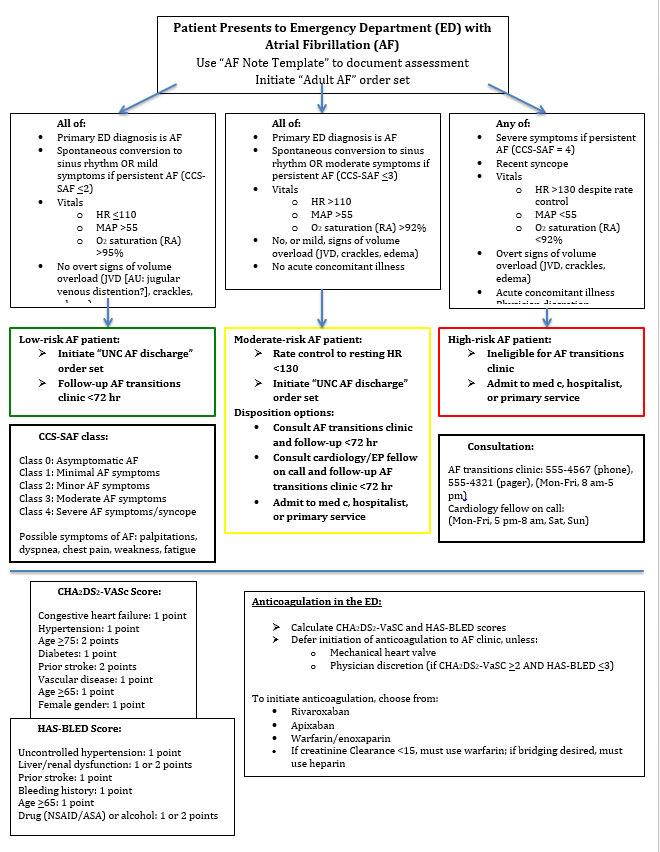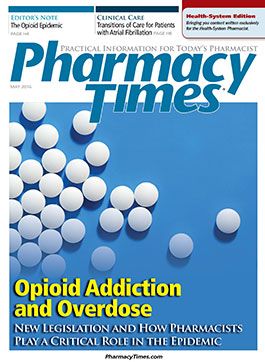Publication
Article
Pharmacy Practice in Focus: Health Systems
Transitions of Care for Patients with Atrial Fibrillation
Author(s):
Atrial fibrillation, the most common cardiac arrhythmia, is strongly associated with increased morbidity and mortality and has become a major global public health challenge.
Atrial fibrillation (AF), the most common cardiac arrhythmia, is strongly associated with increased morbidity and mortality and has become a major global public health challenge.1,2 It is estimated to affect approximately 3 million adults in the United States and 1% to 1.5% of the population throughout the developed world.3 The prevalence of AF increases significantly with age. Given the increasing elderly population in the United States, it has been predicted that over the next 50 years, the number of AF cases will exceed 5.5 million in the United States.
In addition, health care costs associated with AF, after hospitalization, have increased. In 2005, the total cost of care for nonvalvular AF was estimated to be more than $6 billion, with 75% of the cost related to inpatient care alone.2 Kim et al3 conducted a retrospective matched cohort study to estimate the true cost burden of AF in the United States. This study showed that the total direct medical costs were approximately 73% higher in patients with AF compared with the matched control subjects, representing an additional annual cost of $8705 per patient with AF.3
In the United States, between the years 2000 and 2010, there were more than 3 million hospitalizations for which AF was the primary diagnosis at discharge.2 Patel et al2 conducted a study to assess the temporal trends of AF hospitalizations and their economic burden on the health care system. From 2000 to 2010, the number of hospitalizations significantly increased—from 1552 to 1812 per 1 million, respectively. Most of the admissions were for patients 65 years and older, and admissions increased more dramatically after 80 years of age. Although the length of hospital stay did not change over the 10-year period, the cost of care increased significantly after adjustment for inflation.2
The increases in prevalence and cost highlight a need for systematic improvements. It is clear that one way to manage the increasing cost is to reduce the number of hospital admissions and readmissions for AF. Pharmacists play a fundamental role in tackling this public health challenge. Our medical center implemented an AF transitions-of-care (TOC) pathway for patients who present to the emergency department (ED) with a primary diagnosis of AF. The aim of this new treatment paradigm was to decrease hospital admissions and readmissions for AF, and ensure patients have adequate follow-up. The clinic appointments are primarily conducted by Clinical Pharmacist Practitioners (CPPs) with oversight by cardiologists and support from nurses, technicians, and administrative staff.

IMPLEMENTATION
Prior to implementation, it is imperative to elicit support from physician providers. One must also reach out to healthsystem administration, administrative support staff, nursing, other CPPs, ED staff, and clinic providers (eg, cardiology, primary care). Everyone should be involved in designing the implementation plan and triage algorithm to ensure a smooth transition. An operational workflow is helpful to delineate the roles of all involved (Figure 12).

The implementation phase consisted of deploying an ED protocol, which helped identify and select eligible patients, and a note template in the electronic medical record to document key points of the patient assessment. The ED provider risk stratifies each patient as low, moderate, or high risk based on the severity of AF symptoms, which is evaluated using the Canadian Cardiovascular Society Severity of Atrial Fibrillation (CCS-SAF) scale (Figure 24), signs of fluid overload, vitals, occurrence of syncope, and presence of concomitant illness.4 Low-risk patients are routed to the AF TOC clinic; moderate-risk patients can receive treatment (eg, rate-controlling medication) and be observed in the ED, then routed to the AF TOC clinic or admitted to the hospital; and high-risk patients must be admitted to the hospital (Online Figure 3). To be classified as low risk, patients must have a heart rate (HR) ≤110 beats per minute (bpm); therefore, no rate control is required in the ED. Moderate-risk patients have a HR ≥110 bpm, and the ED provider is to initiate rate control to a resting HR <130 bpm. The ED provider also calculates the patient’s CHA2DS2-VASc and HAS-BLED scores to evaluate the risk of stroke and bleeding. If a patient is routed to the AF TOC clinic, anticoagulation initiation may be deferred until followup, unless the patient has a mechanical heart valve, or based on physician discretion when the CHA2DS2-VASc ≥2 and the HAS-BLED ≤3. An order set was developed to guide discharge orders for rate control and antithrombotic agents. If a patient is deemed appropriate for clinic follow-up, the ED health unit coordinator (HUC) requests an AF TOC clinic appointment to be scheduled within 72 hours (goal: 24-48 hr). The cardiology clinic schedulers then add the appointment to the CPP’s schedule in 40-minute blocks reserved for new patients with AF.

The focus of the AF TOC clinic appointment is to conduct a comprehensive review of the patient’s current illness and prior history, evaluate symptoms, assess possible inciting causes of AF, and provide education, as well as determine the need for anticoagulation and rate control therapy, further testing, and referral to a specialist or back to the primary care provider (PCP). The AF TOC clinic relies on a multidisciplinary team to successfully coordinate each patient visit. When a patient presents to the clinic, a nurse obtains the vitals and a technician obtains an electrocardiogram (ECG). After evaluating the ECG, the CPP conducts the patient visit, which takes up most of the appointment. Once the CPP has gathered all necessary information, the CPP discusses the patient and the recommendations with the supervising physician. The physician confirms ECG interpretation and provides input into the therapeutic plan. The physician may see the patient, depending on patient needs. The CPP requests necessary referrals and follow- up appointments, and orders additional diagnostic tests and medications as indicated.
To thoroughly understand the patient’s AF, the CPP obtains a detailed description of the current illness and medical history. The CPP evaluates for a history of AF, prior thrombotic or hemorrhagic events, prior cardiac workup, and AF-related symptoms, including palpitations, dyspnea, dizziness, syncope or presyncope, chest pain, weakness, and fatigue. Based on this information, a CCS-SAF score is calculated to classify the impact of AF on the patient’s quality of life. The CPP also uses targeted questioning and physical examination to identify factors, known or unknown to the patient, that are potentially contributing to the AF. These factors include hypertension, diabetes, obesity, hyperlipidemia, obstructive sleep apnea, tobacco, alcohol or caffeine use, hyperthyroidism, anxiety, heart failure, myocardial infarction, valvular disease, a history of cardiac surgery, and medication nonadherence. After thoroughly evaluating the patient’s comorbidities and symptoms, the CPP determines whether rate control is indicated and calculates CHA2DS2-VASc and HASBLED scores to determine appropriate antithrombotic therapy. The CPP also initiates upstream management of any cardiovascular risk factors that are present.
Throughout the visit, the CPP incorporates detailed patient education regarding AF. This is the first AF episode for most patients; therefore, it is essential that they receive adequate information to make informed decisions regarding the management of their AF. Patient education includes information regarding what AF is, the different types of AF (eg, paroxysmal, persistent), risk factors for the development of AF, minimizing risk of stroke through antithrombotic therapies, managing AF through rate control or rhythm control, and other risk factor management. Lastly, patients are educated on self-management (to empower them to check their pulse at home), when to seek medical care for an AF episode, and instructions for therapeutic lifestyle changes (eg, exercise). This patient information is delivered verbally, and in a comprehensive handout with visual aids.
The final objective of the AF TOC clinic visit is to determine the appropriate next steps for managing the patient’s AF. Patients often warrant further diagnostic testing to rule out possible risk factors or further understand the AF burden (eg, echocardiogram, heart monitor). The clinic visit is designed to mitigate a hospital admission, but should not replace a thorough workup. Whenever possible, patients who already have a PCP or cardiologist are routed to follow up with them to maintain continuity with their current health care network. Alternatively, if the patient is not currently under the care of the appropriate providers, the CPP makes the necessary referrals. Sometimes, this means referring a patient to electrophysiology or providing information on how to set up care with a PCP; other times, this means scheduling a follow-up appointment with the CPP or supervising physician. Regardless of what follow-up is needed, each patient should be set up with a plan to ensure that the AF continues to be managed.
One barrier that routinely occurs in health care is access to providers. To avoid this problem, 1 CPP appointment slot is reserved specifically for AF TOC patients 4 days of the week. Although access is improved, lack of appointment use prevents the time from being used for other types of patient visits. Another downside is if more than 1 patient was referred within the same 72-hour window, double booking of appointments can occur. A potential resolution to this problem is to have the HUC in the ED directly schedule appointments at the time of decision making in the ED.
CONCLUSION
Health care systems and providers throughout the United States are looking for ways to reduce costs. Implementing an AF TOC clinic is an innovative way to enhance AF management by preventing hospitalizations, managing cardiac and metabolic risk factors earlier, and educating patients on self-care and when to seek medical care for AF episodes. The first step to piloting a similar program at your health care system is to speak with health-system administration and other health care providers to gauge interest and work through the logistics (eg, scheduling, clinic space). It is then imperative to educate other providers about your service and to have support from referring physicians to ultimately reduce the number of hospital admissions.
Rachel C. Lee, PharmD, BCPS, CPP, is a PGY2 resident in ambulatory care at University of North Carolina (UNC) Medical Center and Clinics, and a Clinical Pharmacist Practitioner at UNC Internal Medicine Clinic and UNC Hospitals Diabetes and Endocrinology Clinic in Chapel Hill, North Carolina.Mary E. Roth, PharmD, BCPS, CPP, is a PGY2 resident in cardiology at UNC Medical Center and Clinics, and a Clinical Pharmacist Practitioner at UNC Hospitals Heart & Vascular Center at Meadowmont in Chapel Hill, North Carolina.Zachariah M. Deyo, PharmD, BCPS, CPP, is a Clinical Pharmacist Practitioner and quality improvement lead at UNC Hospitals Heart & Vascular Center at Meadowmont, and adjunct assistant professor, PACE Division, at UNC Eshelman School of Pharmacy in Chapel Hill, North Carolina.
References
- Marmagkiolis K, Nikolaidis IG, Politis T, Goldstein L. Approach to and management of the acute stroke patient with atrial fibrillation: a literature review. J Hosp Med. 2008;3(4):326-332. doi: 10.1002/jhm.343.
- Patel N, Deshmukh A, Pant S, et al. Contemporary trends of hospitalization for atrial fibrillation in the United States, 2000 through 2010: implications for healthcare planning. Circulation. 2014;129(23):2371-2379. doi: 10.1161/CIRCULATIONAHA.114.008201.
- Kim MH, Johnston SS, Chu BC, Dalal MR, Schulman KL. Estimation of total incremental health care costs in patients with atrial fibrillation in the United States. Circ Cardiovasc Qual Outcomes. 2011;4(3):313-320. doi: 10.1161/CIRCOUTCOMES.110.958165.
- Dorian P, Cvitkovic SS, Kerr CR, et al. A novel, simple scale for assessing the symptom severity of atrial fibrillation at the bedside: the CCS-SAF scale. Can J Cardiol. 2006;22(5):383-386.






